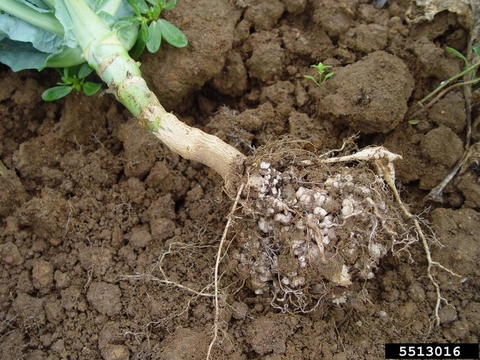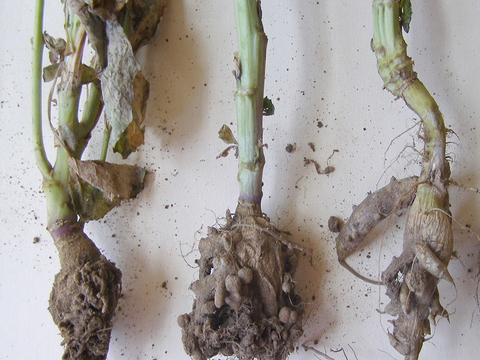Quick facts
- Clubroot is a disease that affects plants in the cabbage family.
- Plants infected by clubroot are stunted, wilt easily and may have yellowing leaves.
- Roots of clubroot infected plants are swollen into thick, irregular club shapes.
- Distribution of clubroot in Minnesota is unknown.
- Infected plants should be composted or buried on site.
How to tell clubroot from other brassica issues
All members of the cabbage family (Brassicaceae) are susceptible to clubroot. This includes cabbage, cauliflower, broccoli, Brussels sprouts, kohlrabi, kale, radish, turnips, rutabaga, mustard greens, collard greens, arugula, bok choy and canola.
- Plants are stunted or wilt with only slight drought stress. Leaves may turn yellow.
- Young plants may be killed. Older plants fail to produce a harvestable head.
- Roots are swollen and distorted into large clubs.
- Clubbed roots are firm and light-colored early in the season.
- Smaller bulbous galls may be seen on secondary roots or coming off a large taproot like a turnip.
- Secondary pathogens can infect clubbed roots, causing them to break down and turn black.
Biology
- Clubroot is caused by the unicellular, parasitic protist Plasmodiophora brassicae. A protist is any eukaryotic organism (an organism whose cells contain a cell nucleus) that is not an animal, plant, or fungus.
- Clubroot is not seed-borne, and most often enters new areas on infected transplants. It can also be brought in on improperly produced compost.
- The pathogen infects roots, which causes them to swell, giving the roots the clubbed experience that gives this disease its name. Infected roots cannot absorb water or nutrients.
- Plants may be infected for a while before you see symptoms above ground.
- The pathogen forms thick-walled spores in infected roots.
- Spores are released into the soil as roots break down and can survive for 20 years.
- Spores can be moved on equipment and tools with clumps of dirt. They can also be moved short distances with strong wind on soil particles.
- Spores become infective again when there is high soil moisture. Clubroot spores are more likely to infect plants in acidic soils (pH below 6.5).
Managing clubroot in the garden
- Prevention is the best way of dealing with clubroot, as it lives long in the soil.
- Grow plants from seeds or purchase transplants from a reputable supplier.
- Inspect transplants for symptoms on roots before planting.
- Only add soil or compost that has been heated to kill pathogens. Compost should reach 148° F while composting. If the source isn’t sure of the process, consider purchasing elsewhere.
- Remove all soil from tools. Clean your tools, then sanitize them with a 1:9 solution of household bleach in water or undiluted Lysol (with the active ingredient 0.1% alkyl dimethylbenzyl ammonium saccharinate).
- If clubroot is found, avoid planting brassicas in affected garden areas for 5 to 7 years. This will help reduce the pathogen population (but not eliminate it).
- Reduce the spread of clubroot to other locations. Bury or compost infected plants on site. Remove all weeds during the crop rotation. The pathogen can survive on many weeds, including non-brassicas that show no clubroot symptoms.
Clubroot resistant varieties of brassica crops are available. They are not completely resistant but can tolerate clubroot better than other varieties. These varieties will perform best when planted after 5 to 7 years during which no member of the cabbage family is grown at the infested site.
Managing clubroot on farms
When scouting for other pests, look for areas of wilted plants. Pull up a few plants and look for clubbed roots to check for clubroot.
If in doubt, submit a sample to the U of MN Plant Disease Clinic. As clubroot is long-lived in the soil, confirm its presence before it becomes widespread on your farm.
Cultural controls
- Prevention is the best way of dealing with clubroot, as it is long-lived in the soil. Avoid planting brassicas in areas with a history of clubroot, especially if the plants are poorly drained.
- Grow plants from seed or purchase transplants from a reputable supplier.
- Inspect transplants for symptoms on roots before planting. If symptoms are found, do not plant any plants from that lot.
- Only add soil or compost that has been heated to kill pathogens. Purchase sterile potting soil from a reputable supplier. Compost should reach 148° F while composting.
- If you purchase compost, ask the supplier about their process; if they are unsure, consider purchasing elsewhere.
- If you make your own compost, follow the National Organic Program’s guidelines for compost to make sure it is adequately heated.
- Remove all soil from tools. Clean your tools and sanitize them with a 1:9 solution of household bleach in water or undiluted Lysol (with the active ingredient 0.1% alkyl dimethylbenzyl ammonium saccharinate) before using them in another field.
- Hose off equipment to remove dirt clumps.
- If clubroot is found, avoid planting brassicas in affected fields for 5 to 7 years. This will help reduce the pathogen population (but not eliminate it).
- Reduce the spread of clubroot to other locations. Bury or compost infected plants on site.
- Remove all weeds during the crop rotation. The pathogen can survive on many weeds, including non-brassicas that show no clubroot symptoms.
Resistant varieties
Clubroot resistant varieties of brassica crops are available. These varieties will perform best when planted after 5 to 7 years during which no member of the cabbage family is grown at the infested site.
Using fungicides
Due to the disease’s soil-borne nature, fungicide options are limited. For current recommendations, see the Midwest Vegetable Production Guide.
Reviewed in 2024





